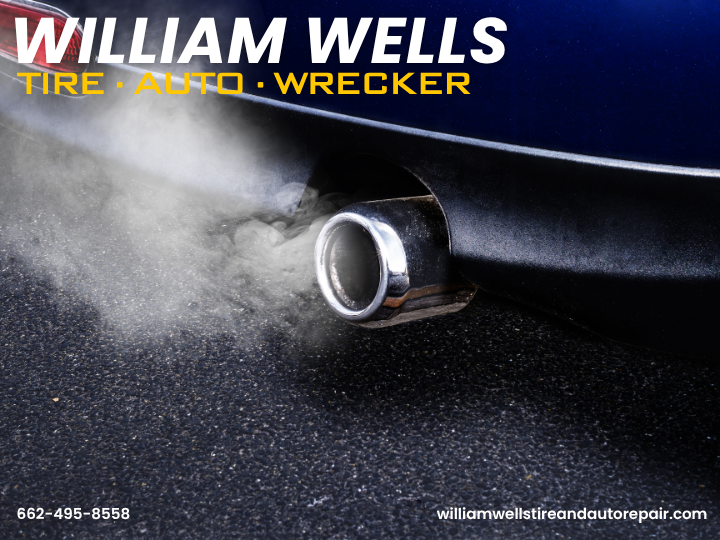Decoding car exhaust colors

Exhaust Smoke Color Meanings: A Comprehensive Guide for Drivers
Introduction: Why Exhaust Smoke Colors Matter for Your Vehicle's Health
Your vehicle's exhaust system is more than just a pathway for expelling gases—it's a key indicator of the engine's internal condition. In a well-maintained car or truck, the exhaust from the tailpipe should be nearly invisible, made up primarily of water vapor, carbon dioxide, and nitrogen. However, when issues arise within the engine, such as fluid leaks, improper combustion, or component wear, the exhaust can become visible and take on distinct colors like white, blue, black, or gray. Each color provides specific clues about potential problems, allowing drivers to address them early and avoid more serious damage, reduced efficiency, or breakdowns.
This detailed blog post, exceeding 4,000 words, offers an in-depth look at exhaust smoke color meanings, drawing from automotive knowledge to provide practical insights. We'll explore the causes for each color in gasoline and diesel engines, common symptoms, diagnostic methods, repair strategies, and prevention tips. Whether you're driving a sedan through city streets, a truck on rural roads, or a hybrid for daily commutes, understanding these signs can help maintain your vehicle's reliability and safety.
Exhaust smoke interpretation is particularly valuable in varying conditions. In areas like Starkville, MS, with its humid climate and temperature fluctuations, factors such as moisture can mimic smoke issues, but knowing the differences is essential. Driving in surrounding regions with mixed urban and highway use can stress engines, making regular monitoring important. By learning to read these signals, you can prevent minor concerns from escalating, reduce emissions, and extend your vehicle's lifespan.
We'll start with the basics of exhaust formation, then dive into each color with expanded sections for thorough coverage. Additional topics include rare smoke variations, differences between engine types, myth debunking, general diagnostics, maintenance practices, and reference tables. Real-world examples will illustrate key points, making this a valuable resource for all drivers.
Exhaust Basics: How Smoke Develops and What It Reveals
To understand smoke colors, it's helpful to know the combustion process. Fuel and air mix in the cylinders, ignited by sparks in gasoline engines or compression in diesels, producing power and byproducts like gases and vapor. These flow through the manifold, catalytic converter to minimize pollutants, and muffler to quiet noise. Clear exhaust indicates balance; colored smoke results from contaminants such as oil (blue tint), coolant (white plumes), or excess fuel (black soot).
Modern systems include sensors for oxygen and airflow, EGR for gas recirculation, and DPFs for particle trapping, but failures disrupt this equilibrium. Vehicle age, mileage (over 100,000 miles increases risk), and habits like short trips (preventing full warm-ups) contribute. In humid environments, steam can resemble smoke, but genuine problems persist with odors or symptoms. Hybrids' on-off engine cycles may produce more vapor but can hide issues.
White Smoke: From Normal Condensation to Critical Leaks
White smoke is one of the most common exhaust observations, but its implications range widely. Density, duration, smell, and context are key to accurate diagnosis.
Normal White Smoke Occurrences
Normal white smoke appears as a light, temporary mist from condensation. Moisture from the air or combustion condenses in cool pipes and evaporates upon heating. It's noticeable on damp mornings or after rain—frequent in Mississippi's humid weather—and fades quickly without scent after starting. Diesels may show brief puffs during glow plug warm-up, and hybrids more often due to intermittent engine use. This is a natural process, requiring no action.
Signs of Problematic White Smoke
Problematic white smoke is thick, persistent beyond engine warm-up, often with a sweet antifreeze odor from coolant burning. Coolant entering cylinders disrupts combustion, creating dense clouds, especially under acceleration. In diesels, it might signal fuel problems instead of coolant, with overlapping diagnostics.
In-Depth Causes of White Smoke
Coolant intrusion occurs due to:
- Head Gasket Failure: Seals the block and head; overheating warps it, allowing leaks. Causes include low coolant, stuck thermostats, or clogged radiators from debris.
- Cylinder Head or Block Cracks: Thermal cycling fractures materials. Aluminum heads are lighter but more prone; heavy loads like towing accelerate this.
- Intake Manifold Gasket Degradation: Allows coolant into intake paths; heat fatigue or installation errors are common.
- EGR Cooler Damage: Recirculation coolers crack, mixing fluids.
- Transmission Vacuum Modulator Fault: Draws fluid in automatic transmissions, burning white.
Diesels: Excess fuel from faulty injectors, low compression (worn rings), or timing issues—worsened in cold conditions.
Other factors: Head warping, gasket defects.
Examples: An overheated truck emits white smoke; a cold-start diesel sedan shows persistent plumes.
Detailed Symptoms of White Smoke
- Coolant loss: Burned internally without external signs.
- Overheating: Gauge fluctuations or spikes.
- Oil contamination: Milky appearance on dipstick.
- Rough performance: Idling instability, power hesitation.
- System bubbles: Gases in reservoir indicate crossover.
These can lead to hydrolock, causing internal damage.
Step-by-Step Diagnostics for White Smoke
- Observation: Note persistence and smell.
- Fluid checks: Monitor levels and conditions.
- Pressure testing: Reveals cooling system leaks.
- Chemical tests: Detects exhaust in coolant.
- Compression evaluations: Checks cylinder integrity.
- OBD scans: Identifies related codes.
Diesels: Injector spray patterns, timing checks.
Tools include gauges, kits, and scanners for home or professional use.
Comprehensive Repair Methods
- Gasket replacement: Involves disassembly and head resurfacing.
- Crack repairs: Welding for aluminum, replacement for severe cases.
- Gasket swaps: For intake or EGR seals.
- Cooler fixes: EGR component renewal.
- Modulator corrections: Transmission vacuum line integrity.
- Diesel adjustments: Injector cleaning, timing realignment.
Follow with system flushes to clear contaminants.
Advanced Prevention Strategies
- Regular coolant changes prevent corrosion.
- Routine inspections of hoses and thermostats.
- Monitoring dashboard warnings.
- Using manufacturer-specified antifreeze.
- Avoiding aggressive cold starts.
- For diesels: Seasonal fuel and glow plug tests.
Annual check-ups reduce risks.
Blue Smoke: Identifying Oil Burning and Wear
Blue smoke, hazy with a sharp burnt-oil smell, indicates oil combusting in cylinders, depleting lubrication.
How Blue Smoke Forms
Oil leaks into combustion areas, burning with the fuel-air mix.
Extensive Causes of Blue Smoke
- Piston Ring Wear: Allows oil past; worsens under load.
- Valve Seal Deterioration: Leaks oil down stems; noticeable on startup or deceleration.
- Turbo Seal Failures: Oil enters air or exhaust in boosted engines.
- PCV System Blockages: Pressure forces oil vapors in.
- Overfilled or Wrong Oil: Promotes splashing into cylinders.
Cylinder scoring from dirt, high mileage.
Examples: High-mileage car accelerates with blue smoke; turbo vehicle at idle.
In-Depth Symptoms of Blue Smoke
- Oil consumption: Frequent top-ups needed.
- Fouled spark plugs: Oily buildup.
- Reduced efficiency and power.
- Eventual knocking sounds.
- Higher emissions during tests.
Catalytic converter clogging from ash.
Broad Diagnostic Procedures
- Pattern logging: When and under what conditions.
- Consumption tracking: Dipstick over miles.
- Wet/dry compression tests: Differentiate rings from valves.
- Vacuum/PCV checks: Gauge for clogs.
- Borescope inspections: Look for scores.
Turbo: Check shaft play.
Repair Techniques Detailed
- Seal renewals: Valve access without full teardown.
- Ring rebuilds: Hone cylinders, install new rings.
- Turbo overhauls: Replace seals and bearings.
- PCV maintenance: Clean or swap components.
- Level corrections: Drain excess oil.
Additives can condition seals temporarily.
Refined Prevention Measures
- Adhere to oil change schedules.
- Use specified synthetic oils.
- Address leaks promptly.
- Implement turbo cooldowns.
- Replace filters regularly.
- Opt for mileage-specific formulations.
Black Smoke: Examining Fuel Imbalances and Inefficiencies
Black smoke, sooty and dense, results from rich fuel mixtures.
Causes in Gasoline Engines
- Sensor Malfunctions: Oxygen or MAF cause overfueling.
- Clogged Air Filters: Restrict airflow.
- Leaking Injectors: Deliver excess fuel.
Diesel-Specific Causes
- DPF Clogging: Soot buildup creates backpressure.
- Injector Problems: Uneven spray.
- Turbo Issues: Insufficient air.
Timing or pump faults.
Examples: Diesel under load; gas with bad sensor.
Symptoms Connected to Black Smoke
- Sluggish acceleration.
- Increased fuel use.
- Sooty deposits on tailpipe.
- Fuel odors.
- Warning lights.
Diagnostic Methods
- Code scans.
- Component inspections.
- Exhaust analyses.
Repair Approaches
- Sensor replacements.
- Filter cleanings or swaps.
- Injector services.
- DPF regenerations.
- Turbo inspections.
Prevention Strategies
- Filter timetables.
- Quality fuels.
- Highway drives for DPF regen.
- Sensor cleanings.
Gray Smoke: Untangling Mixed and Ambiguous Signals
Gray smoke combines characteristics, often from fluid blends.
Possible Causes
- Transmission Fluid Burning: Modulator leaks.
- Oil and Fuel Overlaps.
- PCV or EGR Faults.
Hybrids: Unusual mixtures.
Symptoms and Diagnostics
Variable plumes, performance dips; fluid verifications, tests.
Repairs
Modulator fixes, system cleans.
Rare Smoke Colors and Ideal No-Smoke Scenarios
- Green or Yellow: From dyed coolant.
- Clear Exhaust: The goal for healthy operation.
Table: Quick Smoke Color Reference
Color
Main Cause
Key Symptom
Diagnostic Tool
Common Repair
Prevention Tip
White
Coolant Leak
Sweet Smell
Pressure Tester
Gasket Replacement
Coolant Changes
Blue
Oil Burning
Acrid Odor
Compression Gauge
Ring Rebuild
Oil Schedules
Black
Rich Mixture
Sooty Buildup
OBD Scanner
Sensor Swap
Filter Maintenance
Gray
Mixed Issues
Variable
Fluid Check
System Flush
Routine Inspections
Differences Between Diesel and Gasoline Smoke
Diesels often produce black under load or white on cold starts; gasoline more blue from wear. Diesels involve DPF issues; gasoline sensor failures.
Debunking Myths About Exhaust Smoke
Myth: All white smoke is bad—fact: Condensation is normal. Myth: Smoke disappearing means problem solved—fact: Root cause remains.
General Diagnostic Overviews
Combine observations, tools, and professional input for accuracy.
Holistic Maintenance Practices
- Fluid routines and inspections.
- Varied driving to exercise systems.
- Habitual checks for early detection.
Conclusion: Using Smoke Knowledge to Enhance Vehicle Care
Exhaust smoke colors are essential alerts—white for coolant, blue for oil, black for fuel, gray for mixtures. Awareness promotes longevity.
Should you observe smoke in Starkville or proximate locales such as Columbus, West Point, Tupelo, Aberdeen, Ackerman, Mathiston, Maben, or Cedarbluff, head to William Wells Tire & Auto at 12919 MS-182, Starkville, MS 39759 (662) 268-4081, 1625 Gardner Blvd, Columbus, MS 39702 (662) 240-2414, or 93 W Broad St, West Point, MS 39773 (662) 495-8558. Explore https://www.williamwellstireandautorepair.com/ for skilled assistance.
You can watch the video










